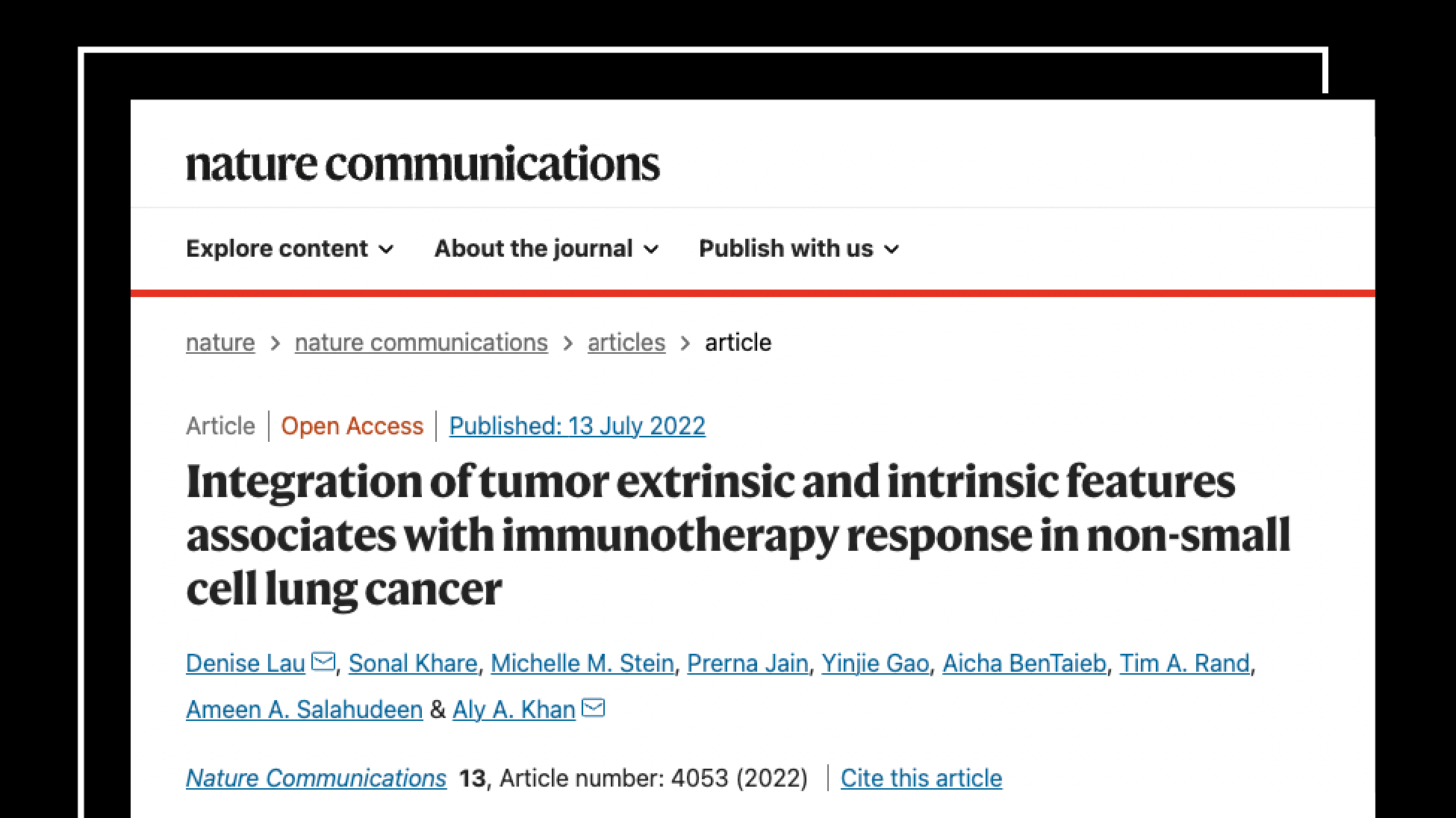-
PROVIDERS
REGISTER NOW
Navigating new frontiers in breast cancer care pathway intelligence: The role of providers and AI
Tuesday, July 29th
2:00pm PT, 4:00pm CT, 5:00pm ET -
LIFE SCIENCES
REGISTER NOW
Closing Care Gaps with AI: The Next Competitive Edge in Pharma
Monday, July 14
9am PT, 11am CT, 12pm ET -
PATIENTS
It's About Time
View the Tempus vision.
- RESOURCES
-
ABOUT US
View Job Postings
We’re looking for people who can change the world.
- INVESTORS
11/08/2022
New research seeks to explain difference in ICB therapy response
Tempus developed an integrative model of tumor-extrinsic and tumor-intrinsic features associated with longer time to progression in NSCLC patients.
Authors
Michelle Stein, PhD
Director, Computational Biology, Tempus

Director, Computational Biology, Tempus

Research summary
In metastatic non-small cell lung cancer (mNSCLC), response rates to PD-(L)1 immune checkpoint blockade (ICB) therapies vary widely, and the mechanisms of response and resistance are not well understood. Previous studies have proposed disruption of HLA class I antigen presentation as an important mechanism of immune escape and ICB resistance, as this may interfere with direct killing of tumor cells by cytotoxic CD8+ T cells.1-3
With rapid advances in DNA and RNA sequencing, the use of linked clinical, genomics, and transcriptomics datasets, like those found in the Tempus Multimodal Database, can be used to facilitate analysis of transcriptional and genomic signatures associated with ICB response, supplementing evidence generated in clinical trials or other studies.
My coauthors and I sought to identify HLA-I-independent features that were associated with ICB response in mNSCLC. We turned to Tempus’s biological modeling laboratory to generate single-cell multiomic profiling datasets from NSCLC tumor specimens – scRNAseq, T cell receptor sequencing, and surface protein profiling – to characterize the tumor and T cell compartments in NSCLC tumors from 10 patients. We discovered a novel population of tumor-infiltrating, clonally expanded CD4+ helper T cells aberrantly expressing genetic programming similar to classical cytotoxic CD8+ killer T cells. In addition, tumor cells from these lung cancers also showed expression of the HLA class II, allowing them to be susceptible to these cytotoxic CD4+ T cells. These findings add to the emerging evidence (Oh et al., Cohen et al., Awad et al.) that cytotoxic CD4+ T cells are a noteworthy component of the tumor immune microenvironment and may play a role in anti-tumor immune responses following treatment with ICB.
We leveraged the single-cell multiomic data to develop a specific transcriptomic signature that captured both CD4+ and CD8+ cytotoxic T cells populations in tumors and applied it to a real-world cohort of mNSCLC patients selected from the Tempus Clinico-genomic Database (n=123). By combining this gene signature for cytotoxicity with tumor mutational burden (TMB), we developed an integrative model of tumor-extrinsic (cytotoxic gene signature) and tumor-intrinsic TMB features that is associated with longer time to progression in a real-world cohort of mNSCLC patients treated with ICB regimens, including those with disrupted class I HLA. These results demonstrate that integrating tumor-extrinsic and tumor-intrinsic features may be an informative biomarker for identifying mNSCLC patients who are more likely to respond to ICB and can remain effective even in populations where tumor HLA-LOH is common.
We are now working with our biopharma partners to apply this novel signature into their programs to improve patient selection. For example, biopharma is:
- Collaborating with Tempus to design and rapidly deploy novel single-cell experiments and compare real-world multimodal data aimed at translating ICB insights into clinical biomarkers.
- Applying our model of ICB response to enhance existing biomarkers of ICB therapies in both the metastatic and neoadjuvant setting in NSCLC and other cancers.
- Further exploring biomarkers of response or resistance to ICB or other therapies of interest in the Tempus Multimodal Database.
- Testing and further developing existing preclinical transcriptional signatures into actionable biomarkers.
Next steps
Contact Tempus to discuss this principled approach with one of our computational biologists. We can dive even deeper with you as it relates to results for your immunotherapy portfolio or design bespoke projects to advance your research and clinical programs.
References
- Sade-Feldman, M. et al. Resistance to checkpoint blockade therapy through inactivation of antigen presentation. Nat. Commun. 8, 1–11 (2017).
- Gettinger, S. et al. Impaired HLA class I antigen processing and presentation as a mechanism of acquired resistance to immune checkpoint inhibitors in lung cancer. Cancer Discov. 7, 1420–1435 (2017).
- Zaretsky, J. M. et al. Mutations associated with acquired resistance to PD-1 blockade in melanoma. N. Engl. J. Med. 375, 819–829 (2016).
READ THE MANUSCRIPT
Lau, D., Khare, S., Stein, M.M. et al. Integration of tumor extrinsic and intrinsic features associates with immunotherapy response in non-small cell lung cancer. Nat Commun 13, 4053 (2022). https://doi.org/10.1038/s41467-022-31769-4
-
07/01/2025
Transforming R&D with Generative AI and Real-World Data
Mike Yasiejko, General Manager and Executive Vice President at Tempus, recently spoke with Andrew Mazar, PhD, Chief Operating Officer at Actuate Therapeutics, about the ways Tempus’ liquid biopsy (xF+) and methylation assays have been valuable to Actuate’s work and how the company has benefitted from the partnership
Watch now -
06/12/2025
AI & ML in action: Demonstrating real-world impact in trial design & patient care
Discover how the Tempus platform leverages AI and ML to inform standard of care practices through health equity guidelines and drive insights that help refine clinical trial design. Engage with live demonstrations showcasing how our tools identify patients by modifying inclusion/exclusion criteria and leveraging patient queries. Explore how our tools integrate NCCN guidelines and empower life science teams to access current, actionable patient-journey insights. Learn how these real-world applications can drive progress in your clinical development initiatives.
Watch replay
Secure your recording now. -
06/09/2025
Bridging the translational gap: The role of organoids in oncology R&D
This white paper explores the evolving role of organoids in oncology R&D, highlighting their potential as predictive preclinical models and their ability to reduce translational risk. Download for a comprehensive overview of the scientific landscape, key adoption barriers, emerging innovations, and how pharma companies leverage organoids to accelerate precision medicine.
Read more



